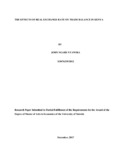| dc.description.abstract | International trade is important for any country through the importation of capital goods. It is also useful in meeting excess demand of the agricultural products and creation of job opportunities for country’s citizens. This international trade is made possible through the principle of comparative advantage. Trade balance is a concept in international trade and is composed of the difference between exports and imports in total value. Trade balance is said to be unfavourable if the value of imports is more than the value of exports. It is said to be favourable if the value of imports is less than that of exports. One of the major determinants of trade balance is real exchange rate.
Real exchange rate refers to amount of local currency at which one unit of the foreign exchange is bought. For Kenyan case, the relationship between real exchange rate and trade balance had not been widely researched by the time this study was carried out. The available few studies gave contradictory findings with regard to the effect of real exchange rate on trade balance. The study used OLS method to estimate long run cointegrating equation. The study carried out diagnostic tests so as to validate the findings. Among the diagnostic tests carried out were heteroscedasticity, autocorrelation, multicollinearity and normality tests. The order of integration for the variables used in the study was investigated using Augmented Dickey Fuller test.
The estimated findings showed joint significance of the explanatory variables in determining trade balance in Kenya. Also, the explanatory variables used in the model were found to explain 93.79 percent of the variation in trade balance. The findings also indicated coefficient of lag one of real exchange rate was found to be positive and separately significant at 0 percent level significance. In addition, the coefficient of lag three and five of foreign income to be positive and individually significant at 10 percent level of significance. Lastly, the coefficient of exchange rate regime was found to be negative and independently significant at 5 percent level of significance.
From the study it is recommended that for the country to control trade deficit the government should depreciate the currency so as to increase export and decrease imports. Also, the government should promote use of country’s exports among country’s trading partners and other countries. This can be achieved through formulation of legislations that will lead to production of
quality goods that meet the requirements of the trading partners. | en_US |



